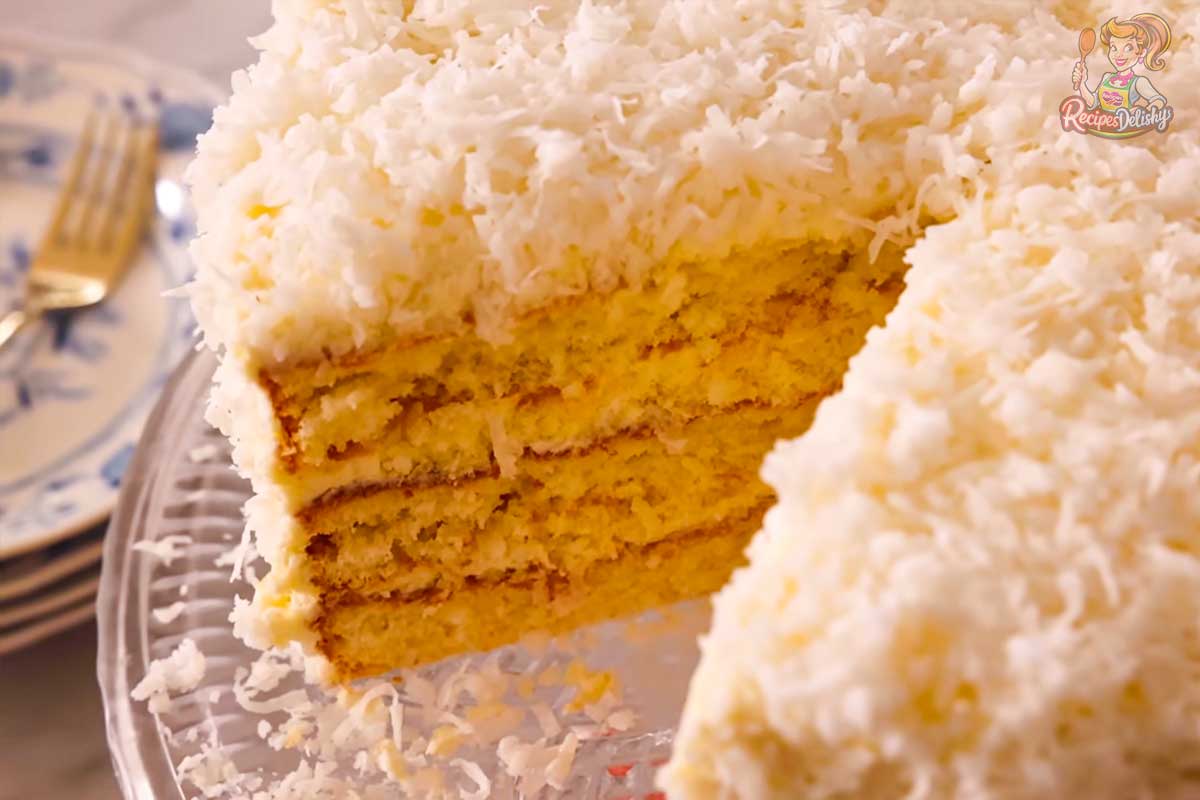Coconut can transform a simple cake into a delightful tropical treat. Its unique texture and sweet flavor make it a favorite among dessert enthusiasts. In this guide, we’ll explore various methods and tips on how to effectively stick coconut to a cake, ensuring it looks as good as it tastes.
Choosing the Right Type of Coconut
The type of coconut you choose can significantly affect both the flavor and texture of your cake. Here’s what you need to consider:
- Fresh vs. Dried Coconut: Fresh coconut provides a juicier and more natural flavor but can be harder to handle and attach. Dried coconut, on the other hand, is easier to sprinkle and stick to the cake.
- Sweetened vs. Unsweetened Coconut: Sweetened coconut is slightly moist and sticks better due to the added sugar which acts like glue when moistened. Unsweetened coconut is better for those preferring less sweetness.
- Texture and Flavor: The texture of the coconut should complement the cake; fine shreds or flakes can cover more uniformly.
For a deeper dive into selecting the best ingredients for your recipes, consider reading about the best practices for choosing baking ingredients.
Preparing the Cake Surface
Before attempting to apply coconut, ensure that the cake surface is properly prepared:
- Cooling: The cake must be completely cool to prevent the frosting from melting.
- Smoothing: The surface should be smooth. Any crumbs or bumps can be covered with a thin layer of frosting to create a smooth canvas.
Adequate preparation of the cake surface ensures that the coconut will adhere properly and stay in place. For more detailed frosting techniques, visit preparing your cake for decoration.
Types of Adhesives for Coconut
Choosing the right adhesive is crucial for getting the coconut to stick effectively:
- Frosting as an Adhesive:
- Cream cheese frosting: Provides a tangy contrast to the sweet coconut.
- Buttercream frosting: Offers a sweet and smooth base.
- Chocolate ganache: Adds a rich flavor and holds coconut well.
- Edible Glue: For a less intrusive taste and a cleaner look, edible glue can be a good alternative.
Applying Coconut to Different Cake Types
Different cake types can present unique challenges when applying coconut. Here’s how to handle each:
- Layer Cakes: Apply a generous layer of frosting and then press the coconut flakes into each layer before stacking.
- Sheet Cakes: Easier to handle as you only need to decorate the top and sides without moving the cake.
- Cupcakes: Dip the top of each frosted cupcake into a bowl of coconut.
Tips for Even Coconut Coverage
Achieving even coverage of coconut on your cake can make a big difference in its presentation:
- Pressing Techniques: Gently press the coconut into the frosting with the back of a spoon or a clean hand to ensure it adheres.
- Handling the Sides: Tilt the cake over a bowl of coconut and use your other hand to press flakes onto the sides.
- Tools: An icing spatula or pastry brush can help manage loose coconut flakes.
Creative Variations and Decorative Ideas
Decorating with coconut allows for creativity. Consider these ideas:
- Combining Decorations: Add nuts, fruits, or edible flowers for color and texture.
- Themed Cakes: Use dyed coconut flakes to match the theme of the event.
- Visual Impact: Colored coconut can add a stunning visual element to any cake.
Maintenance and Storage of Coconut-Covered Cakes
Proper maintenance and storage are crucial to preserving the aesthetic appeal and freshness of coconut-covered cakes. Here are detailed steps and tips to ensure your cake remains delicious and visually appealing from the moment it’s decorated until it’s served:
Immediate Aftercare
- Let Settle: After decorating your cake with coconut, allow it to sit for a short period. This helps the coconut adhere to the frosting or other adhesive, reducing the chance of it falling off during movement or slicing.
- Room Temperature Settling: Keep the cake at room temperature for an hour or two if your frosting is butter-based, as it helps the fats in the frosting to crystallize and hold the coconut better.
Storage Tips
- Cool and Dry Place: Store the cake in a cool and dry place to prevent the coconut from becoming soggy. Excessive humidity or heat can cause the frosting to melt, which might result in the coconut sliding off or clumping together.
- Cover Lightly: Use a cake dome or an inverted bowl to cover the cake lightly. Direct contact with plastic wrap or aluminum foil might press down on the coconut and disturb its arrangement.
Refrigeration
- Refrigerating Your Cake: If you need to refrigerate the cake (which might be necessary in warm climates or if the cake contains perishable fillings), do so for the shortest time possible. Extended refrigeration can dry out the cake and alter the texture of the coconut.
- Airtight Containers: If possible, place the cake in an airtight container to protect it from absorbing odors from other foods and to maintain its moisture.
Serving After Storage
- Bring to Room Temperature: Before serving, bring the cake back to room temperature to ensure that the frosting softens and the flavors are more pronounced. This generally takes about an hour depending on the cake size.
- Freshening Up: If the coconut has lost its crunch or looks a bit wilted, lightly toast some fresh coconut flakes and sprinkle them on the cake before serving to restore its vibrant texture and fresh taste.
Long-term Storage
- Freezing: For long-term storage, coconut-covered cakes can be frozen. However, it’s ideal to freeze the cake without the coconut and add fresh coconut after thawing to maintain the best texture and flavor. If freezing the decorated cake is necessary, wrap it tightly in several layers of plastic wrap and then in foil to protect it from freezer burn.
By following these storage and maintenance tips, your coconut-covered cake will maintain its quality and delight your guests both visually and gastronomically.
How do you stick coconut to a cake?
Step-by-Step Guide
Sticking coconut to a cake is a straightforward process that can greatly enhance the appearance and taste of your dessert. Here’s how you can do it:
- Prepare the Cake: Ensure your cake is fully cooled and has a flat surface. Trim any domed tops and loose crumbs to achieve a smooth base.
- Choose Your Coconut: Decide whether you want to use shredded, flaked, or desiccated coconut based on your texture preference and the look you are aiming for.
- Apply a Sticky Base:
- Frosting: Apply a thin, even layer of frosting over your cake. Buttercream, cream cheese, or even a simple glaze can act as excellent adhesives for coconut.
- Brush with Syrup: Alternatively, for a less sweet option, lightly brush the cake with a simple syrup or warmed apricot jam to make the surface sticky.
- Apply the Coconut:
- Hand Application: Take handfuls of coconut and gently press them against the sides and top of the cake. Turn the cake as you go to ensure even coverage.
- Bowl Method: For less mess, you can also roll the sides of the cake in a large bowl filled with coconut.
- Pat It Down: Once the coconut is applied, gently press it into the frosting or sticky base to ensure it adheres well.
- Clean Up: Brush off any excess coconut that didn’t stick to ensure a clean presentation.
- Set It: Allow the cake to set for a few minutes so the coconut can stick securely to the frosting or glaze.
Expert Tips for Perfect Results
- Moisture Is Key: Ensure that your frosting or glaze is moist enough to hold the coconut but not so wet that it causes the coconut to clump.
- Room Temperature Ingredients: Use room temperature frosting or jam for easier application and smoother coverage.
- Toast for Extra Flavor: Toasting the coconut lightly before applying it to the cake can add a delightful crunch and enhanced coconut flavor. Just make sure to cool it completely before application.
- Handling: Handle the cake gently while applying coconut to prevent the base from becoming uneven or the frosting from smearing.
- Storage: Once the coconut is applied, store the cake in a cool, dry place to prevent the coconut from absorbing moisture and becoming soggy.
Using these step-by-step instructions and tips, you can master the art of decorating cakes with coconut, ensuring they not only look stunning but also taste delicious.
Techniques for Sticking Coconut to a Cake
Using Frostings as Adhesives
Frostings not only enhance the flavor of cakes but also serve as excellent adhesives for sticking coconut flakes or shreds. The key is to choose a frosting that complements the flavor of your cake and has the right consistency to hold the coconut securely.
Best Frostings for Holding Coconut
- Buttercream Frosting: This classic choice is thick enough to support coconut shreds, providing a smooth, buttery background that doesn’t overpower the coconut’s flavor. It’s versatile and can be flavored or colored as desired.
- Cream Cheese Frosting: Ideal for carrot or red velvet cakes, this tangy frosting offers a nice contrast to the sweetness of coconut. Its sticky texture makes it particularly effective for coconut adhesion.
- Chocolate Ganache: When slightly cooled, ganache thickens to a spreadable consistency that is perfect for adhering coconut. It adds a rich, decadent flavor and works especially well with darker coconut types.
- Whipped Cream Frosting: For lighter cakes like sponge or angel food, whipped cream offers a light, airy base that can still hold coconut if applied thickly and used promptly before serving.
- Royal Icing: For a firmer hold, royal icing sets hard and ensures that coconut stays in place, ideal for decorative touches on more formal cakes.
Alternative Methods Without Frosting
Not everyone prefers a frosted cake, but you can still adhere coconut with a few simple techniques that skip the frosting altogether.
Pressing Coconut into Bare Cake Surfaces
- Syrup or Jam: Brushing your cake with a light layer of simple syrup or slightly warmed fruit jam can provide enough tackiness for the coconut to stick. This method enhances the cake’s moisture and flavor without the heaviness of frosting.
- Honey or Agave: For a natural alternative, lightly drizzle honey or agave over the cake surface. These are stickier than syrups and provide a stronger hold, along with a subtle sweetness that complements the coconut.
- Melted Chocolate: Apply a thin layer of melted chocolate over your cake. As the chocolate cools, it creates a sticky surface that’s perfect for pressing coconut into. This is particularly effective for creating dense, richly flavored cake exteriors.
- Edible Glue: Edible glue, available at cake decorating stores, can be brushed onto the cake where you want the coconut to stick. This is a great option if you’re looking for a very clean and professional finish.
These techniques allow for flexibility in cake design and flavor pairings, ensuring that the coconut not only looks good but is also securely attached, whether you use traditional frostings or opt for an alternative method.
FAQs
- What type of coconut is best for sticking to cakes? Sweetened shredded coconut generally sticks better due to its moisture content.
- How do I make coconut stick to the sides of a cake? Apply a thin layer of frosting and gently press the coconut against it.
- Can I use liquid glaze instead of frosting to adhere coconut? Yes, but ensure it’s thick enough to hold the coconut flakes.
- How long will a coconut-covered cake stay fresh? Typically, it can last up to three days if stored properly in the refrigerator.
This comprehensive guide should help you master the art of decorating cakes with coconut, making your next baking project a sure success!

